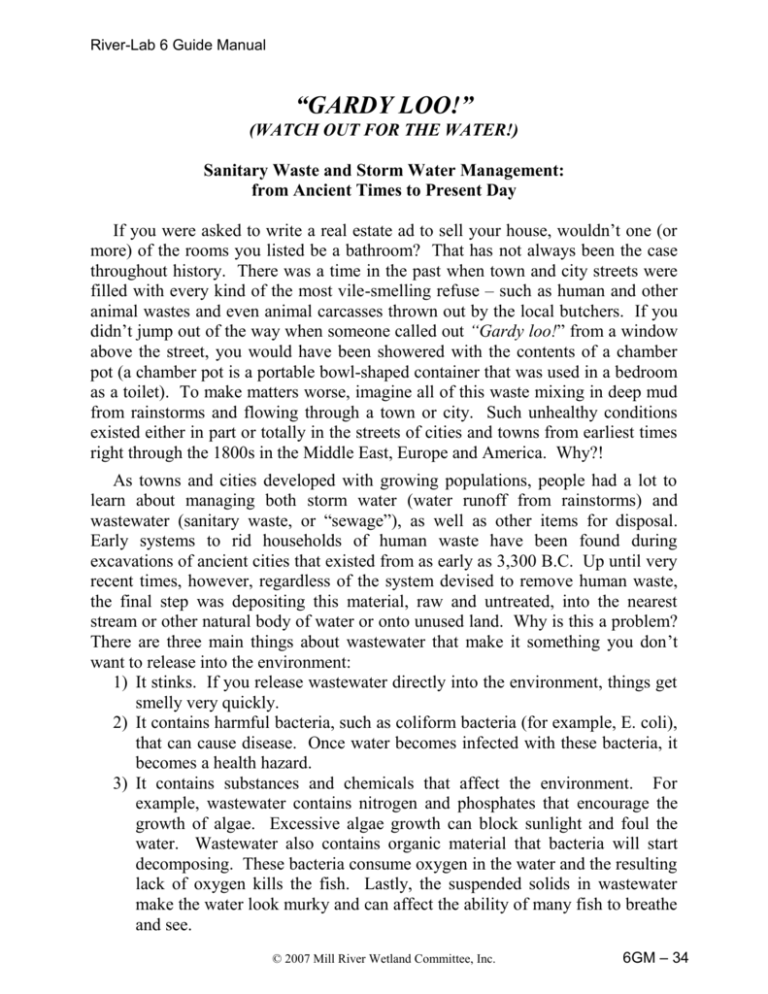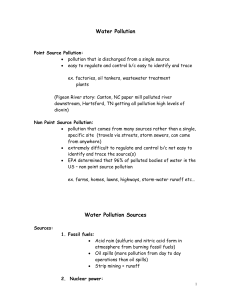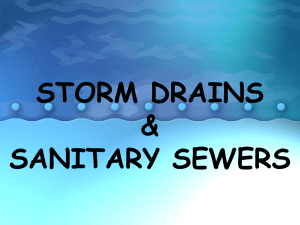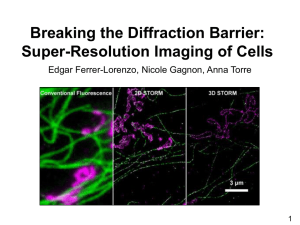The Management of Waste Water and Storm Water - River-Lab
advertisement

River-Lab 6 Guide Manual “GARDY LOO!” (WATCH OUT FOR THE WATER!) Sanitary Waste and Storm Water Management: from Ancient Times to Present Day If you were asked to write a real estate ad to sell your house, wouldn’t one (or more) of the rooms you listed be a bathroom? That has not always been the case throughout history. There was a time in the past when town and city streets were filled with every kind of the most vile-smelling refuse – such as human and other animal wastes and even animal carcasses thrown out by the local butchers. If you didn’t jump out of the way when someone called out “Gardy loo!” from a window above the street, you would have been showered with the contents of a chamber pot (a chamber pot is a portable bowl-shaped container that was used in a bedroom as a toilet). To make matters worse, imagine all of this waste mixing in deep mud from rainstorms and flowing through a town or city. Such unhealthy conditions existed either in part or totally in the streets of cities and towns from earliest times right through the 1800s in the Middle East, Europe and America. Why?! As towns and cities developed with growing populations, people had a lot to learn about managing both storm water (water runoff from rainstorms) and wastewater (sanitary waste, or “sewage”), as well as other items for disposal. Early systems to rid households of human waste have been found during excavations of ancient cities that existed from as early as 3,300 B.C. Up until very recent times, however, regardless of the system devised to remove human waste, the final step was depositing this material, raw and untreated, into the nearest stream or other natural body of water or onto unused land. Why is this a problem? There are three main things about wastewater that make it something you don’t want to release into the environment: 1) It stinks. If you release wastewater directly into the environment, things get smelly very quickly. 2) It contains harmful bacteria, such as coliform bacteria (for example, E. coli), that can cause disease. Once water becomes infected with these bacteria, it becomes a health hazard. 3) It contains substances and chemicals that affect the environment. For example, wastewater contains nitrogen and phosphates that encourage the growth of algae. Excessive algae growth can block sunlight and foul the water. Wastewater also contains organic material that bacteria will start decomposing. These bacteria consume oxygen in the water and the resulting lack of oxygen kills the fish. Lastly, the suspended solids in wastewater make the water look murky and can affect the ability of many fish to breathe and see. © 2007 Mill River Wetland Committee, Inc. 6GM – 34 River-Lab 6 Guide Manual – Gardy Loo! In the past, natural water sources or rainfall were generally accepted as the way to have sanitary waste carried away through the city or town. Street sewers were common over the centuries. They were often open channels, down the middle of the street. Thus, storm water management and sanitary waste management were a combined operation from the beginning of civilization. Only fairly recent advances in scientific research, starting in the 1800s, have led to understanding of the need to control and treat each of these kinds of waste water separately and return only the cleanest possible water back into the environment. Ancient Management Practices 3,300 B.C. – 500 A.D. In the ancient world, there were many ways to treat waste – some were as simplistic as sweeping wastes into the streets and others were much more technologically advanced. Some ancient systems of sanitary waste management involved piping that still is basic to modern systems. The city of Habuba al Kabira (3,300 B.C.) stood on an upper stream of the Euphrates River in the part of the world called Mesopotamia, which is now occupied by Iraq and Syria. It is the earliest known city to have pipes to carry off sanitary waste water. In cities of the Indus Valley (present day Pakistan) from about 2500 to 1500 B.C., some houses had bathrooms with flushing toilets! They had well-designed drainage systems. The Greek civilization, starting from around 1500 B.C., had the earliest environmentally clean system of ancient times. They constructed well-planned urban (city) drainage systems. Along with their concern to avoid harmful flooding, they avoided polluting the surrounding waters of their environment. The waterflushed sewers of Athens sent human and other wastes to a collecting basin outside the city. Flow from this basin was channeled to irrigate and fertilize their orchards and fields. The waste treatment management practices of the Romans were the most developed of any civilization prior to the 19 th century. In fact, they were better than those in the Middle Ages! Roman engineering was very advanced; they built great aqueducts from streams or springs to ensure enough water for Rome and other outlying or conquered cities. They saw that all tapped and storm water was well managed. A huge sixteen-foot wide underground tunnel, called the Cloaca Maxima, became the largest combination sanitary and storm sewer of ancient times and is still in use. As Roman civilization developed, between 600 and 500 B.C., the Romans still flushed most of their waste to the River Tiber through open sewers. They kept their cities clean but fouled the natural system. Studies of ancient civilizations have revealed some remarkable attention to the cleanliness of persons, homes and streets, but far less to the surrounding natural environment. For most early civilizations, the final management “solution” was “disappearing” their wastes, however transported, in a natural body of water. This 6GM – 35 © 2007 Mill River Wetland Committee, Inc. River-Lab 6 Guide Manual – Gardy Loo! “solution” would persist and eventually become a problem as human populations and cities continued to grow. 500 – 1500 A.D. Middle Ages The decline of the Roman empire meant the loss of a controlling government to enforce the rules and systems of water management and sanitation. Very little Roman engineering know-how regarding such systems had spread to conquered lands, such as England and France. With no reliable supply of clean water, no control over storm water and no sanitary systems, people lived with the accumulations of their filth, and disease was common and became rampant. During the Middle Ages, or “Medieval” period, management continued to be limited to dumping in a river or out on open ground, burying in cess-pits, and allowing collected material to be carted to outlying farms for fertilizer. Open ditch sewers for storm water carried industrial pollution of tanners and dyers to local rivers and streams. In spite of unhealthy living conditions, cities continued to grow, which caused increased crowding and even more dumping of wastes in city streets. Rats, carrying a deadly disease, multiplied in the cities as they ate the wastes and began to infect the people. This situation caused the Great Plague, known as the “Black Death,” which killed one-third of the people in Europe between 1348 and 1350 – a time of horror beyond belief! The Renaissance Period and Age of Enlightenment 1500 – 1800 In this time period, more concern was given to health and water issues, as there was an increasing lack of acceptance of the vile conditions of the Middle Ages. The cesspool was one of the technical developments of the Renaissance. It is a simple pit that allowed solids to settle and the liquid to seep into the ground. During the 1600s, basic European waste management practices arrived on the newly-discovered American continent. Construction of stone roads in cities, such as Boston and New York, increased storm water runoff and river pollution. Laws regarding disposal methods generally only followed major outbreaks of disease, and such rules had no lasting effects. The unhealthy and irregular pattern of depending on leaky carts or storm water to remove waste continued. The concern remained focused on human living conditions and not on the abused natural waters. The Industrial Revolution 1800 – 1920 The transition from handmade to machine-driven industry that started in the early 1800s made conditions in cities so much worse that it finally provoked real change in waste management, yet there still was no concern for the condition of rivers. In the mid-1800s, management thinking turned strongly in favor of using flowing water to remove sanitary wastes. This change was the result of a widespread cholera epidemic in Europe, 1840-1860, and the increasing concern © 2007 Mill River Wetland Committee, Inc. 6GM – 36 River-Lab 6 Guide Manual – Gardy Loo! that such disease could be caused by germs carried in human waste. Advances in sewer engineering and better piping made the use of flowing water possible. Progress in waste management also continued with the invention of the septic tank in 1860 by a Frenchman, Louis Moureas. The septic tank allows solid materials to settle on the bottom as the liquid portion passes through. The first use of this system – to serve large communities, letting the liquid seep into local streams – resulted in vile stream conditions. There was an understanding of removing the solids, a potential problem for public health, but the remaining liquid (effluent) was largely untreated and caused pollution of streams and rivers. Early in the 1880s, the evidence needed to support sound sanitary management was finally discovered. Studies of bacteria by the French and German doctors, Louis Pasteur and Robert Koch, led to the isolation of typhoid and cholera germs under the microscope and confirmed the connection to raw sewage. Public support for sewer system funding grew quickly and many large systems were built in major cities in Europe and America. All sewering, however, continued to dump into the rivers because people believed this kind of “dilution” was a solution. Towns and cities in America also moved forward with measures to handle sanitary waste and storm water runoff. The Twentieth Century to Present Day 1900 – 2006 The growth of cities in America and abroad increased storm drainage problems, as well as sanitary concerns. Because serious health crises were related to sanitary waste, development of sanitary sewer piping and treatment systems received the most immediate attention in the 1900s. However, increasing storm water runoff was growing as well, as the use of cars and trucks grew and more roads were paved. Why is storm water a problem? When it rains, or snow and ice melt, the water that does not seep into the ground flushes down our streets to nearby storm sewers. In the present day, this water becomes polluted with hydrocarbons, grease, oil and antifreeze that drips from our cars and trucks, detergents, pesticides and other pollutants that get washed from driveways, backyards, parking lots and streets. This polluted runoff flows freely to our waters. By the early 1900s, drainage in cities – of both storm water and sanitary effluent – became established as a public works responsibility. The Hudson River had become so polluted that a New York City Sewage Commission was set up in 1906 to get a treatment system installed. It was estimated that the raw sewage of over 20 million city-dwelling Americans was being poured into streams, rivers or lakes! The dangers of sewer germs getting into drinking water, through ground water or in rivers used for water supply were now well known. Experiments in sanitary sewage treatment focused on promoting biological “digestion,” or the conversion of waste material by microorganisms. 6GM – 37 © 2007 Mill River Wetland Committee, Inc. River-Lab 6 Guide Manual – Gardy Loo! The technology to protect natural inland and coastal water resources was developing, but the expense of sanitary sewage treatment (installing and operating) still kept many communities from using the systems they needed. Many older cities with combined sanitary and storm systems felt they could not afford to separate them. Whey heavy rains sent more storm water through combined system pipes to a treatment plant, these older systems overflowed, polluting rivers and coastal areas. Recreational beaches along rivers and at the seashores were often affected, as were fishing areas and shellfish beds. Septic tanks in towns often overflowed as businesses grew close together. Rural communities were also beginning to have to spend more on storm water management. For example, in 1926, Fairfield (Connecticut) installed its first underground storm water piping to drain a portion of the town’s main street, the Post Road. This drain emptied into the Mill River, the main river of the town. There was little concern at this point in time as to what new chemicals, fuel or grease might be going into the natural system. However, in 1948, a Federal Water Pollution Act was passed, becoming the first major set of laws to control pollution of natural bodies of water in America. During the 1950s and 1960s, concern for the natural environment began to take its place as part of concern for human health. Governments in America and abroad became more deeply involved in research that advanced technology and understanding of the impacts of both storm and sanitary wastewater on the natural water systems. More people had become aware that, in addition to their need for pure drinking water, healthy coastal and river habitats for food and recreation were also vital to their quality of life. The improved research technology of the 1950s also led to the recognition that storm water running off the surfaces of developed communities was not only causing flooding and erosion, but was also contaminating bodies of water. The lawns and paved areas that replace natural covering as communities are built cause runoff from rain or snowmelt to flow down even faster. Another concern was that storm water was not staying on the ground long enough to sink in and keep underground water at levels that could send water out to surface water bodies (ponds, lakes, streams and wetlands) in dry seasons. In addition, analysis of runoff showed it carried a load of substances similar to sanitary wastewater. Water conservation laws were established both locally and nationally, in the late 1960s and early 1970s to address concerns about water pollution. In 1967 the Connecticut Clean Water Act was passed which set up standards and provided means of enforcement. In 1970, the National Environmental Policy Act was passed in America, and the United States Environmental Protection Agency (EPA) was set up, with an office in each state (Department of Environmental Protection in Connecticut). The purpose of this program was to strengthen air, water and solid waste management across the country. © 2007 Mill River Wetland Committee, Inc. 6GM – 38 River-Lab 6 Guide Manual – Gardy Loo! There were still concerns about the effectiveness and reliability of sewage treatment and the need for greater attention to the pollution in storm water runoff. Sources of water pollutants are classified into two types: point sources and nonpoint sources. Point sources are easy to identify – you can see them. Wastewater coming out of a pipe or ditch directly into a body of water from a building such as a factory is considered point source pollution. Nonpoint pollution sources are not so easy to identify or control. Nonpoint source pollution occurs when rainfall or snowmelt moves across the land. The runoff is made up of eroded soil, animal wastes, and man-made chemicals (including lawn fertilizers). Runoff may have high concentrations of pollutants such as trace metals and oil, as well as other content similar to sanitary sewage – bacteria and organic nutrients high in nitrogen and phosphates. Runoff, by definition, can end up in lakes, rivers, coastal waters, and ground water. Nonpoint source pollution was identified during the 1970s as the cause of “dead areas” in coastal waters such as Long Island Sound. According to the EPA, nonpoint source pollution is now the biggest cause of water quality problems in the country. Increasingly from the 1970s, engineers had been trying to deal with nonpoint source pollution and fast runoff. As communities became aware of this runoff problem, various means to delay and treat runoff began to be a part of development designs. Some systems were designed to hold back the flow for a while (retention) and others designed to keep the water (detention) and allow it to seep underground. Where possible, runoff from retention or detention systems would be piped to a nearby wetland or pond. This route allowed nutrients still contained in the storm water to be caught on plants and become part of the food chain in that natural system. In the late 1970s and during the 1980s, major efforts were directed in America toward reducing point source pollution. In Fairfield, between 1980 and 2002, many more houses with septic systems were added to the sanitary sewer trunk lines and connected to the Fairfield treatment plant, which received a major multimillion dollar renovation and expansion between 1999 and 2002. Eighty percent of the plant was upgraded with improved systems and additional treatment units. Because of the similarity between what is contained in storm water runoff and sanitary sewage, community efforts to reduce nonpoint source pollution involve similar principles of treatment. Just as sewage treatment plants have primary treatment to remove trash and grit, such as stones and sand, available storm sewering systems now include a variety of designs to trap such material. Systems are also available that trap grease and other floating pollutants. Some of the organic runoff debris, containing nitrogen and other nutrients remains trapped in the sand and stones. Systems are available to remove over 90% of the suspended solids and organic pollutants in storm water. However, communities are not always able to afford the best technology for either sanitary or storm water 6GM – 39 © 2007 Mill River Wetland Committee, Inc. River-Lab 6 Guide Manual – Gardy Loo! management. As with a sanitary treatment plant, a storm water management system involves costs of maintaining the system, as well as the cost of preparing and installing it. Many developed countries now understand that wastewater management must include protecting the environment as well as guarding people from community health problems. That cry of “Gardy loo!” stirs citizens everywhere to watch out for pollution in all bodies of freshwater, as well as in estuaries and along the coast. An article that appeared in the Fairfield Minuteman in October 2006, noted that the town of Fairfield has invested about $40 million in upgrading its sewage facility, surpassing state standards and cutting the amount of nitrogen entering the waters around the town. This investment shows the commitment of the town to the health of Long Island Sound. Individuals can do a lot, as well, particularly with reducing fast runoff from their properties. On our own grounds, replacing lawn with absorbent, mulched gardens, supporting the use of porous paving wherever suitable and even installing cisterns to catch and reuse our roof runoff could make a great difference in both storm water and sanitary management. We can also avoid using fertilizers with high concentrations of nitrogen or pick up grass clippings for removal or composting. We could also not wash our cars or change the oil in our driveways, because oil, suds and dirt could, through runoff, get into the Sound. There’s much that can be done. The Environmental Protection Agency is an excellent resource for information on what we can do to protect the waters of our environment. For example, a brochure from the EPA on steps we can take in our homes that can help prevent storm water pollution is available at Fairfield Town Hall or online at www.fairfieldct.org. Or, visit the EPA at www.epa.gov/ebtpages/water.html for a wealth of material and information on water quality and environmental protection. We have come along way in separating them in many cases but these two forms of wastewater are still combining to cause environmental impacts because of our continuing ignorance and negligence. Additional resources: Evolution of Sewage Treatment: www.cet.nau.edu/Projects/WDP/resources/History/History.htm New England Interstaste Water Pollution Control Commission: http://www.neiwpcc.org/Index.htm?Contact.htm~mainFrame Soundkeeper’s Filter Project: www.soundkeeper.org Howstuffworks: “How Sewer and Septic Systems Work”: www.howstuffworks.com/sewer.htm/printable After the Storm: a Citizen’s Guide to Understanding Stormwater http://www.epa.gov/npdes/pubs/after_the_storm.pdf © 2007 Mill River Wetland Committee, Inc. 6GM – 40







